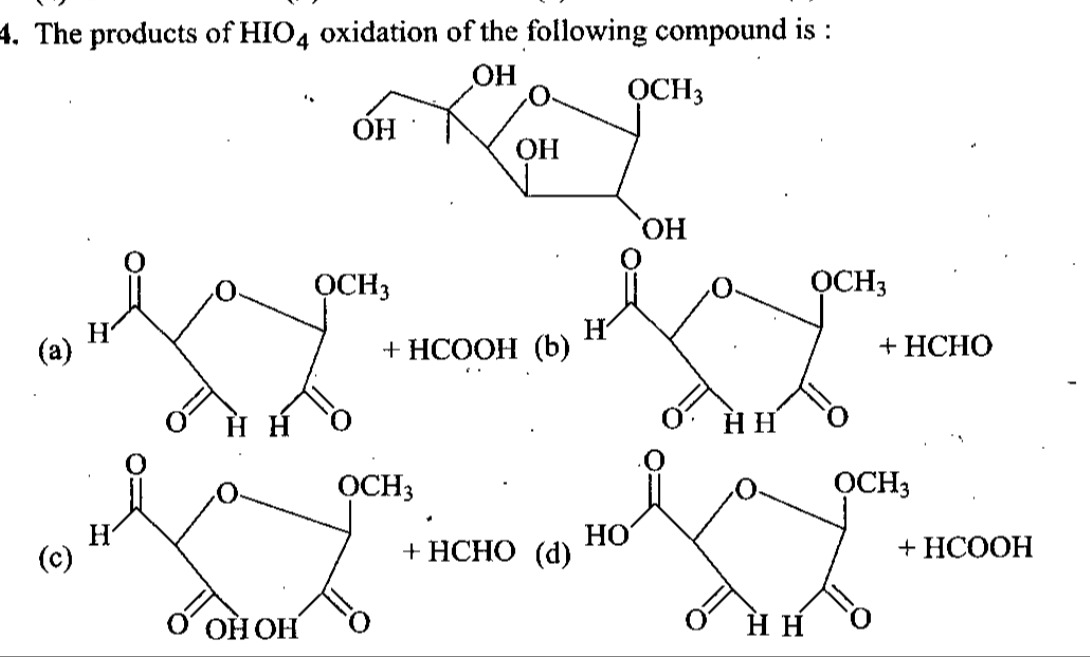Question
Question: The products of $HIO_4$ oxidation of the following compound is :...
The products of HIO4 oxidation of the following compound is :

(a)
(b)
(c)
(d)
(d)
Solution
The starting material is a furanose derivative. Periodic acid (HIO4) cleaves vicinal diols. The molecule has vicinal diols at C2-C3, C3-C4, and C4-C5.
-
Cleavage of C4-C5: The CH2OH group at C5 and the OH group at C4 are vicinal. This cleavage opens the C4-C5 bond, oxidizing C5 to formaldehyde (HCHO) and C4 to a carboxylic acid.
-
Cleavage of C3-C4: The OH groups at C3 and C4 are vicinal. This cleavage opens the C3-C4 bond, oxidizing C3 to an aldehyde and C4 to a carboxylic acid.
-
Cleavage of C2-C3: The OH groups at C2 and C3 are vicinal. This cleavage opens the C2-C3 bond, oxidizing C2 to a ketone and C3 to a carboxylic acid.
Considering the given options, option (d) shows a cyclic product and formic acid (HCOOH). The cyclic product is a 5-membered ring. If we assume the ring is formed by O-C1-C2-C3, with C1 having the OCH3 group, C2 having a carbonyl group, and C3 having a carboxylic acid group, this implies:
- The C2-C3 bond was cleaved, forming a carbonyl at C2 and a carboxylic acid at C3.
- The C4-C5 bond was cleaved, forming HCHO from C5.
- The C3-C4 bond was cleaved, and C4 was oxidized to a carboxylic acid. However, the product shown is HCOOH.
A closer look at the structure and the cleavage pattern reveals that the C2-C3 and C4-C5 bonds are cleaved.
- Cleavage of C4-C5 yields HCHO.
- Cleavage of C2-C3 yields a ketone at C2 and a carboxylic acid at C3.
- The remaining part, including the ring oxygen, C1, C2, and C3, forms the cyclic product.
The structure of the cyclic product in option (d) corresponds to the fragment O-C1-C2-C3 where C2 is a ketone and C3 is a carboxylic acid. The HCOOH is formed from the C4 and C5 fragment. This happens if C4 is oxidized to HCOOH and C5 is oxidized to HCHO. This is not consistent with standard vicinal diol cleavage.
Let's re-evaluate the common outcome of HIO4 oxidation on sugars. It cleaves C-C bonds between carbons bearing hydroxyl groups. If the starting material is a furanose with OH at C2, C3, C4, and C5:
- Cleavage of C4-C5 gives HCHO and a carboxylic acid from C4.
- Cleavage of C3-C4 gives an aldehyde from C3 and a carboxylic acid from C4.
- Cleavage of C2-C3 gives a ketone from C2 and a carboxylic acid from C3.
The product in (d) is a cyclic compound and HCOOH. The cyclic compound has a carbonyl at C2 and a carboxylic acid at C3. This suggests cleavage of C2-C3. The HCOOH implies that C4 was oxidized to formic acid. This can happen if C4 was part of a fragment that yielded formic acid.
Given the options, the most plausible outcome is the cleavage of C2-C3 and C4-C5 bonds. Cleavage of C4-C5 results in HCHO. Cleavage of C2-C3 results in a ketone at C2 and a carboxylic acid at C3. The cyclic product shown in (d) is consistent with this cleavage pattern, forming a 5-membered ring. The HCOOH product is unusual in this context if C4 is oxidized to a carboxylic acid. However, among the given choices, (d) is the most representative of the expected products from periodic acid cleavage of such a structure, assuming some specific oxidation pathways for the resulting fragments.
